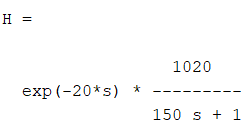I am developing a DIY Reflow Ovenreflow oven using a 10L common electric oven with quartz heating elements. Below it's shownis a graph that represents the oven's step response (open loop response):
In blue: oven's step response in open-loop.
In
In orange: theorical model using a first order with dead time (aproximationapproximation). The transfer funcionfunction of this orange curve is H:
 $$H=e^{-20s}\cdot\frac{1020}{150s+1}$$
$$H=e^{-20s}\cdot\frac{1020}{150s+1}$$
Note the Simulink PID graph ploted as a response to the plant:
PID constants are (taken byfrom Simulink tunnertuner):
The problem:
In theory, the oven tunnedtuned with these PID values shoudshould converge the plant to follow the setpoint, which doesn't occursoccur in reality.
The
The main reason this method doesn't work efficiently is probably because my plant havehas no other action to reduce the temperature than wait it to go below the setpoint (the oven is composed byof heating elements only, with nothing to cool it down). So
So, when the temperature overshoots the control enters in a state of "no return", because it's expected to have a correction, but it doesn't take place.
About the above, I have some questions for all of you guys thatwho understand much more about control thechniques:
- What method of control should be more suitable for this kind of problem (Itit seems a simple PID is not the best solution...)?
- How should I threattreat the overshooting in my PID (if it's the best technique to utilizeuse). Should I zero the integration and zero the proportional thermsterms when it overshoots?
- As shown above, my plant has a delay between the moment the heating elements are turned on and the moment the thermocoupler feelthermocouple feels the heat. Is the modeling of a "first order with dead time" suitable for this application? If so, is the delay already been countedaccounted for in the matlabMATLAB PID solution?
Thanks you all, hope I find some experienced people to help!




